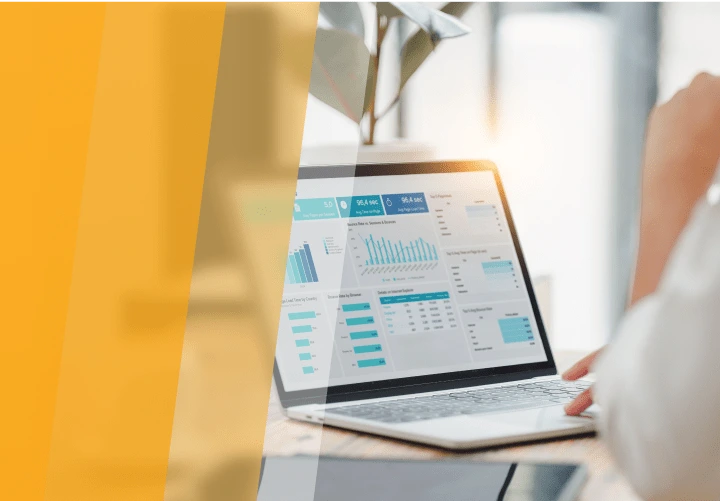Web Portal Development for Healthcare
Table of contents
- Types of Web Portals for Healthcare
- 1. Patient Portals
- 2. Providers Portals:
- 3. Administrative Portals:
- 4. Telehealth Portals:
- 5. Research Portals:
- How Web Portal Can Benefit Your Business
- Essential Web Portal Features Your Patients & Staff Will Love
- Unveiling Healthcare Industry Standards for Web Portal Development
- Conclusion
In today's digital age, web portals have become an indispensable tool for businesses across various industries. In the healthcare sector, web portal development has gained significant traction, revolutionizing the way healthcare providers interact with patients, streamline operations, and improve overall efficiency. We will explore the benefits of the web portals for healthcare businesses, the different types of web portals, essential web portal features and the importance of compliance with industry standards. By leveraging these trends, entrepreneurs can create innovative solutions, enhance patient care, and drive business growth.
If you need an expert opinion, support, or the full cycle development for your business, get in touch with the Emerline team for a consultation. We have been helping companies for over 12 years and are ready to assist you in your business journey.
Types of Web Portals for Healthcare
There are different types of web portals designed to cater to specific needs within the healthcare sector:
1. Patient Portals
Patient portals are perhaps the most common type of web portals in healthcare. They allow patients to securely access their personal health information, such as medical records, lab results, and appointment schedules. Patients can also communicate with healthcare providers, request prescription refills, and view educational resources. Patient portals empower individuals to take an active role in their healthcare journey, promoting engagement and better health management.
2. Providers Portals:
Provider portals are designed to facilitate efficient communication and collaboration among healthcare providers. These portals enable healthcare professionals to securely share patient information, including medical records, test results, and treatment plans. Provider portals streamline care coordination, allowing doctors, nurses, and specialists to collaborate seamlessly and make informed decisions for the best patient outcomes.
3. Administrative Portals:
Administrative portals focus on the operational aspects of healthcare organizations. They help manage administrative tasks such as appointment scheduling, billing, insurance verification, and inventory management. Administrative portals automate these processes, reducing paperwork, minimizing errors, and improving efficiency. By streamlining administrative tasks, healthcare organizations can allocate more time and resources to providing quality patient care.
4. Telehealth Portals:
Telehealth portals have gained significant popularity, especially in recent times. These portals enable remote consultations and virtual healthcare services. Patients can connect with healthcare providers through video calls, receive medical advice, and even get prescriptions remotely. Telehealth portals have proven to be invaluable, particularly in rural areas or during emergencies when in-person visits may not be feasible.
5. Research Portals:
Research portals cater to the needs of researchers and scientists in the healthcare field. These portals provide access to medical literature, research articles, clinical trials, and other relevant resources. Researchers can collaborate, share findings, and contribute to advancements in medical knowledge. Research portals play a crucial role in innovation and fostering improving healthcare practices.
How Web Portal Can Benefit Your Business
In this fast-paced digital era, having a strong online presence is paramount for success. A web portal can be your secret weapon, providing a multitude of benefits that can propel your business to new heights.
At its core, a web portal serves as a centralized platform, bringing together a wide range of resources, information, and services in one convenient location. This not only enhances efficiency but also improves user experience. With a well-designed portal, your patients, employees, and partners can easily access relevant data, collaborate seamlessly.
Web portals offer numerous advantages to healthcare businesses, including:
1. Improved Patient Engagement:
A web portal for healthcare enables patients to access their medical records, schedule appointments, request prescription refills, and communicate with healthcare providers conveniently. Patient engagement refers to the involvement of individuals in managing their own healthcare. It encompasses active participation, shared decision-making, and effective communication between patients and healthcare providers. By empowering patients to take an active role in their healthcare journey, improved patient engagement leads to better health outcomes and increased patient satisfaction.
Benefits of Improved Patient Engagement:
a) Enhanced Treatment Adherence: Patients who are actively engaged in their healthcare are more likely to adhere to treatment plans, medication schedules, and lifestyle modifications. This leads to better disease management and improved overall health.
b) Shared Decision-Making: When patients are actively involved in decision-making processes, they have a better understanding of their conditions and treatment options. This collaborative approach fosters trust, improves patient satisfaction, and ensures that healthcare decisions align with the patient's preferences and goals.
c) Improved Health Outcomes: Patient engagement has been linked to improved health outcomes in various areas, including chronic disease management, preventive care, and patient safety.
d) Technology Integration: Leveraging technology solutions, such as mobile applications or wearable devices, can enable patients to monitor their health, access medical records, and communicate with healthcare providers more efficiently.
2. Streamlined Operations:
Web portals automate administrative tasks such as appointment scheduling, billing, and insurance verification. This automation reduces paperwork, minimizes errors, and improves operational efficiency. By streamlining these processes, your staff can focus on delivering quality patient care and spend less time on administrative tasks.
Benefits of Streamlined Operations:
a) Increased Efficiency: Streamlined operations eliminate bottlenecks and unnecessary steps, enabling healthcare providers to deliver care in a more timely and efficient manner. This leads to reduced waiting times, improved patient flow, and enhanced overall operational efficiency.
b) Cost Reduction: By identifying and eliminating waste, streamlined operations help healthcare organizations reduce costs. This can include minimizing inventory, optimizing staffing levels, and reducing unnecessary administrative tasks. The resulting cost savings can be redirected towards improving patient care and investing in innovative technologies.
c) Enhanced Patient Care: Efficient operations directly impact patient care by ensuring timely access to services, reducing medical errors, and improving coordination between healthcare teams. Streamlining operations promotes a patient-centered approach, where care is delivered promptly, accurately, and with a focus on individual needs and preferences.
d) Improved Staff Satisfaction: Streamlined operations alleviate administrative burdens, enabling healthcare professionals to focus more on patient care. By reducing unnecessary tasks and optimizing workflows, staff members experience increased job satisfaction and can dedicate more time to meaningful patient interactions.
3. Enhanced Communication:
Web portals facilitate secure and seamless communication between patients, healthcare providers, and staff members. Patients can ask questions, receive test results, and request referrals or medication refills through secure messaging systems. Improved communication leads to better care coordination, faster response times, and ultimately, improved patient satisfaction.
Benefits of Enhanced Communication in Healthcare:
a) Patient Safety: Clear and effective communication among healthcare providers helps prevent medical errors, such as medication errors or misdiagnoses. Enhanced communication ensures accurate transmission of critical information, reduces the risk of misunderstandings, and promotes a culture of safety.
b) Patient Satisfaction: Open and transparent communication between healthcare providers and patients fosters trust, engagement, and satisfaction. When patients feel heard and understood, they are more likely to actively participate in their care, follow treatment plans, and have a positive healthcare experience.
c) Care Coordination: Effective communication enables seamless coordination and collaboration among healthcare teams. By sharing information, test results, and treatment plans in a timely manner, healthcare professionals can ensure continuity of care, reduce duplication of services, and enhance the overall patient experience.
d) Improved Outcomes: Enhanced communication leads to better health outcomes. When healthcare providers communicate clearly with patients, they can ensure that patients understand their conditions, treatment options, and self-management strategies. This empowers patients to actively participate in their care, leading to improved adherence to treatment plans and overall better health outcomes.
4. Increased Access to Information:
A web portal provides 24/7 access to healthcare services and information. Patients can view lab results, access educational resources, and receive personalized health recommendations. This increased accessibility allows patients to actively manage their health, leading to better self-care and prevention of potential health issues.
Benefits of Increased Access to Information in Healthcare:
a) Patient Empowerment: When patients have access to comprehensive medical information, they can better understand their conditions, treatment options, and potential risks. This empowers them to actively engage in shared decision-making with their healthcare providers, leading to personalized, patient-centered care plans.
b) Improved Health Literacy: Accessible information promotes health literacy, allowing patients to understand medical terminology, test results, and treatment guidelines. This knowledge equips patients to take proactive steps in managing their health, leading to better adherence to treatment plans and improved health outcomes.
5. Efficient Appointment Management:
With a web portal, patients can conveniently schedule and manage their appointments online. This feature reduces phone calls, eliminates wait times, and improves patient flow. Additionally, automated appointment reminders can help reduce no-shows, ensuring optimal utilization of healthcare resources.
Benefits of Efficient Appointment Management:
a) Enhanced Patient Experience: Efficient appointment management minimizes waiting times, reducing patient frustration and anxiety. Patients appreciate a well-organized system that respects their time and provides them with prompt access to healthcare services. This improves overall patient satisfaction and loyalty.
b) Optimal Resource Utilization: Effective appointment management enables healthcare providers to allocate resources efficiently. By accurately assessing the demand for appointments, providers can optimize staff schedules, manage equipment and facilities, and ensure that patient care is delivered in a timely manner.
c) Reduced No-Show Rates: Efficient appointment management helps minimize patient no-shows, which can significantly impact healthcare operations. Through appointment reminders, confirmations, and easy rescheduling options, healthcare facilities can reduce the number of missed appointments, improving both patient care and revenue.
d) Improved Workflow and Efficiency: Streamlining appointment management processes leads to improved workflow and operational efficiency within healthcare organizations. By minimizing scheduling conflicts, optimizing patient flow, and reducing administrative burden, healthcare providers can focus more on delivering quality care to patients.
6. Secure Handling of Patient Data:
Web portals prioritize the security and confidentiality of patient data. They adhere to industry standards, such as HIPAA (Health Insurance Portability and Accountability Act), ensuring the protection of sensitive patient information. This instills trust among patients, knowing that their data is handled with utmost care and compliance.
Benefits of Secure Handling of Patient Data:
a) Patient Confidentiality: Ensuring the secure handling of patient data is essential to maintain patient confidentiality. Patients trust healthcare providers with their sensitive information, and any breach can lead to a loss of trust and potential harm. By implementing robust security measures, healthcare organizations can safeguard patient data and maintain confidentiality, preserving the doctor-patient relationship.
b) Compliance with Privacy Regulations: The healthcare industry is subject to various privacy regulations, such as the Health Insurance Portability and Accountability Act (HIPAA) in the United States. Secure handling of patient data ensures compliance with these regulations, avoiding legal consequences and potential fines.
c) Protection against Data Breaches: Data breaches can have severe consequences, including identity theft, financial loss, and damage to the reputation of healthcare organizations. By implementing secure handling practices, such as encryption, access controls, and regular security audits, healthcare providers can minimize the risk of data breaches and protect patient information.
d) Enhanced Patient Trust: Patients value their privacy and expect healthcare providers to handle their data securely. By prioritizing data security, healthcare organizations can build and maintain trust with their patients, fostering long-term relationships and patient loyalty.
7. Cost Savings:
Implementing a web portal for healthcare can lead to significant cost savings. By automating administrative tasks and reducing paperwork, you can save on operational expenses. Additionally, improved patient engagement and communication can lead to better adherence to treatment plans, reducing hospital readmissions and associated costs.
Essential Web Portal Features Your Patients & Staff Will Love
To ensure a seamless user experience and maximize productivity, it is crucial to incorporate features that cater to the needs of both patients and staff
1. Secure Patient Authentication:
A robust web portal should prioritize patient privacy and security. Implementing secure patient authentication features, such as two-factor authentication or biometric login options, ensures that only authorized individuals can access sensitive medical information. This feature not only instills confidence in patients but also safeguards their data from unauthorized access.
2. User-friendly Interface:
A user-friendly interface is essential for both patients and staff to navigate the web portal effortlessly. Intuitive design, clear navigation menus, and well-organized information contribute to a positive user experience. Consider implementing a responsive design that adapts to different devices, such as smartphones and tablets, allowing users to access the portal from anywhere, at any time.
3. Appointment Scheduling and Reminders:
Streamline the appointment scheduling process by integrating a feature that allows patients to book or reschedule appointments online. This functionality reduces the administrative burden on staff and provides patients with the convenience of managing their appointments at their own convenience. Additionally, automated appointment reminders via email or SMS can help reduce no-shows and improve overall patient attendance rates.
4. Secure Messaging and Telehealth:
Facilitate seamless communication between patients and healthcare providers through secure messaging features. This allows patients to ask questions, request prescription refills, or seek clarifications without the need for a phone call or an in-person visit. Integrating telehealth capabilities within the web portal can also provide patients with the option of virtual consultations, expanding access to care and improving patient satisfaction.
5. Access to Personal Health Records:
Enabling patients to access their personal health records through the web portal empowers them to take an active role in managing their health. Patients can review lab results, medication lists, immunization records, and other important health information. Providing a comprehensive view of their medical history fosters better patient engagement and facilitates more informed discussions with healthcare providers.
6. Online Bill Payment:
Simplify the billing process by incorporating an online bill payment feature. Patients can securely view and pay their bills directly through the web portal, eliminating the need for paper statements and manual payment processing. This feature not only improves patient convenience but also reduces administrative overhead and accelerates payment collection.
7. Staff Collaboration and Workflow Management:
In addition to patient-focused features, it is crucial to have tools that enhance staff collaboration and workflow management. Implement features that allow staff members to securely communicate, share documents, and collaborate on patient cases within the web portal. This promotes efficient teamwork, reduces communication gaps, and streamlines administrative processes.
Unveiling Healthcare Industry Standards for Web Portal Development
To ensure the development of effective and secure web portals, it is crucial to adhere to industry standards.
1. Compliance with HIPAA Regulations:
Health Insurance Portability and Accountability Act (HIPAA) regulations are fundamental in safeguarding patient privacy and the security of their health information. When developing web portals for the healthcare industry, it is vital to ensure compliance with HIPAA standards. This includes implementing robust security measures, encryption protocols, and secure data storage practices to protect patient data from unauthorized access.
2. User Authentication and Authorization:
Web portals should incorporate strong user authentication and authorization mechanisms to ensure that only authorized individuals can access confidential patient information. Implementing secure login credentials, multi-factor authentication, and role-based access control (RBAC) ensures that users can only access the information relevant to their roles and responsibilities within the healthcare organization.
3. Interoperability and Data Exchange:
Interoperability is a critical standard in healthcare web portal development, allowing seamless data exchange between different systems and applications. Integration with electronic health records (EHRs), laboratory information systems, and other healthcare systems ensures that patient data is accurately and efficiently shared across various platforms. Compliance with industry standards like Health Level Seven International (HL7) and Fast Healthcare Interoperability Resources (FHIR) facilitates smooth interoperability and data exchange.
4. User Experience and Accessibility:
Healthcare web portals should prioritize user experience and accessibility to ensure maximum engagement and usability for patients, healthcare providers, and administrators. Designing user-friendly interfaces, intuitive navigation menus, and responsive layouts that adapt to different devices ensures that users can access the portal effortlessly from desktops, laptops, tablets, and smartphones. Additionally, adhering to accessibility standards, such as Web Content Accessibility Guidelines (WCAG), ensures that individuals with disabilities can use the portal without barriers.
5. Secure Messaging and Communication:
Web portals should provide secure messaging capabilities to facilitate efficient communication between patients and healthcare providers. Implementing encrypted messaging features ensures that sensitive patient information remains confidential during communication. Compliance with industry standards, such as the Direct Project, enables secure and standardized exchange of health information between healthcare organizations, improving care coordination and patient engagement.
6. Continuous Security Assessments and Updates:
To maintain the highest level of security, healthcare web portals should undergo regular security assessments and updates. This includes vulnerability assessments, penetration testing, and staying up-to-date with the latest security patches and protocols. Regular audits and risk assessments help identify and address potential security vulnerabilities, ensuring the protection of patient data and compliance with industry standards.
Conclusion
Web portal development has become a game-changer for the healthcare industry, offering improved patient engagement, streamlined operations, enhanced communication, and increased accessibility. By understanding the different types of web portals, the services they offer, the importance of compliance with healthcare industry standards, and the steps involved in web portal development, healthcare businesses can leverage this technology to deliver better patient care and achieve operational excellence.
If you need more information on web portal development for Healthcare, Emerline has your back. Contact our web portal development experts for consultation and turnkey solutions for your business.
Published on Jun 20, 2023





